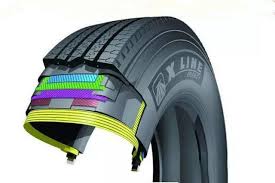Why Don’T Cars Have Inner Tubes?
We all know that bicycles are composed of an inner tube and an outer tire. If there is a puncture, you usually need to repair the inner tube, and then check whether there is any foreign matter inside the outer tire. If the inner tube is severely damaged, just replace the inner tube. But have you ever thought about why cars don’t have inner tubes?
Tubeless tires are often called "low-pressure tires" and "tubeless tires" and are divided into two types: radial tires and bias tires.
Both bias tires and radial tires are pneumatic tires, and they are named respectively according to the different fitting forms of the carcass ply.

Pneumatic tires are mainly composed of rubber parts and plies. Although the tire may appear to be "covered" with rubber, the rubber in the tire carcass only plays the role of combining the components of the carcass, sealing, wear resistance, puncture resistance and partial buffering. It does not really "contribute". What makes a difference is the curtain hidden inside the rubber.
In order to reduce the stress on the cords, people increase the number of cord layers on the one hand, and on the other hand they arrange the cord warps in the carcass to cross each other at a certain angle.
Because the cord warps of two adjacent layers cross each other obliquely, people call this kind of tire with the cords together called "bias tires." The angle at which the cord intersects perpendicularly with the centerline of the crown is called the "crown angle".
On the surface of the globe, lines are often marked connecting the North and South Poles, which are the meridians.
If the cords of a radial tire are exposed through the sidewall, and its endpoints are imagined to be extended to the tire axis, then the cord arrangement of this tire is very similar to the radial arrangement on a globe, and the radial tire is therefore And got its name.
Tubeless tires have many advantages. Generally speaking, they have the following four major advantages:
Advantage 1: fuel saving
Vacuum tires, especially radial tires, have a zero crown angle and strong adhesion, which can maintain better driving stability and less friction, which is beneficial to shock absorption and increased vehicle speed.
The belt speed layer has high positioning, the wheel has small radial runout and resistance, so it is more fuel-efficient.
Advantage 2: Security
The surface of the vacuum tire is a layer of rubber. After inflating, the outer surface tension increases, forming a certain pressure on the inner surface, which improves the self-sealing ability of the breach. Once punctured, it will not collapse instantly like a bicycle.
If you encounter nails or the like, it won't be a big problem if the vacuum tires keep running for one or two hundred kilometers.
Advantage 3: wear resistance
Especially for radial tires, because the crown angle is zero, the change is small when the vehicle is moving forward at high speed, and it can maintain good driving stability and small friction, which is conducive to the absorption of vibration shock and the increase of vehicle speed.
Advantage 4: Stability
Tubeless tires require high manufacturing precision because the tire and wheel rim are sealed together. Most of them are die-cast aluminum integrated wheel hubs, which have high positioning between tires and extremely small radial runout of the wheel.
The comfort and stability of motorcycles using tubeless tires are much better than those using ordinary tires.

Comments
0